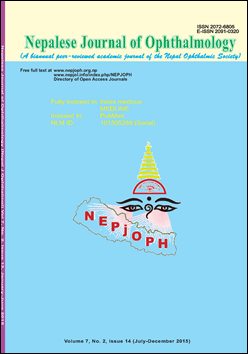Comparative Study of Dry Eye Indices Following Cataract Surgery
DOI:
https://doi.org/10.3126/nepjoph.v13i1.29313Keywords:
Dry eye, Cataract surgery, Lissamine green surface staining, Ocular surface disease index, Schirmer 1 test, Tear breakup time.Abstract
Background: This study aims to assess dry eye indices following cataract surgery.
Materials and Methods: A single center descriptive and comparative study was performed. A total of 100 eyes of 100 cases fulfilling the inclusion criteria from 1st June 2017 to 30th May 2018 were enrolled. Out of 100 eyes, 50 eyes each went through manual small incision cataract surgery (MSICS) and phacoemulsification respectively. For objective analysis : schirmer 1 test(ST-I), tear breakup Time(TBUT) along with lissamine Green Surface Staining(LGSS) was performed on pre-operative day, 1st, 4th and 12th week respectively. Ocular Surface Disease Index (OSDI) was done for subjective analysis on pre-operative day and at 12th week.
Results: The mean age of the patient was 53.66 ± 7.839 years with 34 (68%) being female in a small incision cataract surgery group. In the phacoemulsification group, mean age was 54.72 ± 7.985 years and 32 (64%) were female. On analyzing the objective dry eye indices: ST-I,TBUT and LGSS at 12thweek was 18.80 ± 7.393 mm, 11.30 ± 5.456 seconds and 1.62 ± 1.193 in Small incision cataract surgery group and 27.10 ± 6.326 mm, 16.60 ± 4.699 seconds and 0.38 ± 0.602 in Phacoemulsification group respectively which was statistically significant. (p< 0.001).
Conclusion: Regardless of the type of cataract surgery, dry eye disease is unavoidable affecting both tear quality and quantity postoperatively. In our study, phacoemulsification had lesser effect in dry eye indices than small incision cataract surgery.
Downloads
Downloads
Published
How to Cite
Issue
Section
License
This license enables reusers to copy and distribute the material in any medium or format in unadapted form only, for noncommercial purposes only, and only so long as attribution is given to the creator.




